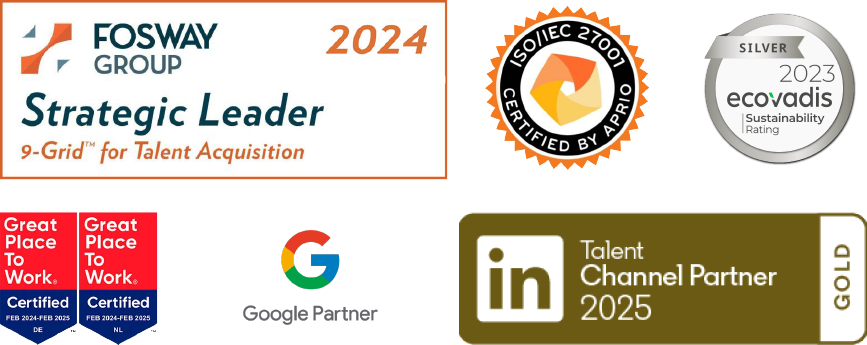Recruitment advertising is essential in today’s ever-evolving job market, serving as a vital link between employers and job seekers. In a world where the employment landscape constantly changes, staying ahead of the curve is critical for companies looking to attract top talent.
As we enter 2024, we find ourselves in a dynamic and uncertain economic environment characterized by unique challenges and opportunities. To successfully navigate this ever-changing terrain, recruiters and hiring managers must do more than identify current trends; they must embody the core of the recruitment challenge.
In recruitment advertising, this extends beyond the boundaries of knowledge alone. It encompasses anticipating, adapting, and managing change within the recruitment landscape. Staying competitive means staying on top of emerging trends, understanding the nuances of the job market, and harnessing the power of data-driven insights.
Moderate Hiring Demand
One of the prevailing trends in 2023 was the moderation of hiring demand. According to the Indeed Hiring Lab’s EMEA Hiring Trend Report for 2024, in December 2023, Germany saw a 12% decrease in hiring compared to the previous year. However, it’s important to note that the hiring rate was 36% higher than before the COVID-19 pandemic in 2020. Additionally, there was a significant 39% decrease in hiring in the HR sector compared to April 2022.
This moderation in hiring demand should not be seen as a cause for concern but rather as an opportunity to adapt recruitment strategies accordingly.
HR Professionals might want to prioritize these recruitment strategies:
- Targeted Role-Focused Recruitment: Focus on a targeted approach to fill critical positions, prioritizing the most essential roles and sourcing candidates specifically for these roles to optimize recruitment efforts.
- Strengthen Employee Retention: Invest in employee retention strategies, such as competitive compensation, positive work culture, and career development opportunities, to reduce turnover and minimize the need for frequent hiring.
- Enhance Job Posting Visibility: Increase the visibility of job postings through various channels like online job boards and social media, ensuring they are attractive and accurately reflect the company’s values to attract suitable candidates.
By focusing on these strategies, organizations can effectively navigate the trend of moderate hiring demand, filling key positions efficiently while maintaining a robust and stable workforce.
Influx of Prime-Age Workers
The participation rate of prime-age workers (aged 25 to 54) surged in 2023, driven by post-pandemic immigration and returning sidelined workers. Predictions for 2024 indicate continued workforce growth, with an influx of younger workers and an aging population. This is a crucial trend highlighted in Forbes’s “The Job Seeker’s Guide to 2024’s Job Market.” However, a long-term challenge arises with an aging workforce – the shrinking talent pool as aging workers retire.
To address this challenge, we would recommend to consider these strategies:
- Training and Upskilling: Prioritize training and upskilling programs to bridge the skills gap between retiring older employees and incoming younger workers, ensuring a smooth transition and maintaining a skilled workforce.
- Multi-Generational Workforce Strategy: Develop policies and practices that cater to a diverse age range, including flexible work arrangements and mentorship programs, to leverage the strengths of older and younger workers.
- Inclusive Recruitment: Implement inclusive recruitment practices to attract diverse candidates, ensuring job descriptions and recruitment processes are free from age biases and emphasizing the company’s commitment to diversity and inclusion.
Considering these strategies, organizations can address the immediate needs of a changing workforce and prepare for long-term success by creating a dynamic, skilled, and diverse employee base.
Stable Quitting Rate
The end of the Great Resignation in 2023 marked a plateau in the quit rate. This trend is favorable for 2024, as it leads to increased hiring from the unemployed pool rather than employees simply switching jobs. As emphasized in Forbes’ “The Job Seeker’s Guide to 2024’s Job Market, talent retention measures remain essential.
Our recommendations for HR professionals:
- Enhance Talent Retention and Employer Branding: Focus on retaining existing employees by offering competitive benefits, fostering a positive work environment, and providing growth opportunities. Simultaneously, strengthen employer branding to attract top talent, highlighting the company’s values, culture, and unique advantages.
- Target Unemployed and Re-Entering Candidates: Adjust recruitment efforts to appeal to those who are unemployed or re-entering the workforce. This involves tailoring job descriptions and outreach strategies to meet this candidate pool’s needs and interests, emphasizing job stability, training opportunities, and support for career transitions.
- Leverage Technology and Diversify Recruitment Channels: Utilize advanced HR technologies and data analytics to understand market trends and candidate preferences better. Diversify recruitment channels to reach a broader and more diverse applicant base, ensuring inclusive hiring practices and effectively tapping into different talent pools.
A stable quitting rate allows HR professionals to refine their recruitment strategies, focusing on retention, employer branding, diversity and inclusion, and leveraging technology. This approach not only helps attract new talent but also contributes to the overall satisfaction and productivity of the existing workforce.
Downward Trend in Wage Growth
Nominal wage growth is expected to cool down in 2024, returning to pre-pandemic levels. According to the EMEA Hiring Trend Report for 2024, wage growth in Germany declined to 4.3%, and in the EU, it dropped to 3.8% after reaching peaks in October 2023.
While this may not result in a spike in unemployment, it could impact workers’ purchasing power. Organizations should consider offering inflation-adjusted raises to ensure that employees can maintain their standard of living, aligning with the findings from ING’s report on the European staffing sector in 2024.
From an HR perspective, you might want to look into:
- Offer Inflation-Adjusted Raises: While nominal wage growth is cooling, organizations need to offer inflation-adjusted raises to help employees maintain their standard of living. This approach can be crucial in retaining staff and ensuring their financial well-being, especially in a challenging economic environment.
- Enhance Non-Monetary Benefits: As wage growth slows, enhancing non-monetary benefits can be an effective strategy. This includes flexible working arrangements, additional paid time off, health and wellness programs, and opportunities for professional development. These benefits can add significant value to the overall compensation package and help attract and retain employees.
- Focus on Employee Engagement and Satisfaction: Focusing on employee engagement and job satisfaction becomes even more crucial with limited ability to increase wages. This can involve creating a positive work environment, recognizing and appreciating employees’ contributions, and ensuring open and transparent communication. A satisfied workforce is more likely to stay loyal and productive, even when wage increases are modest.
Increased Usage of Generative AI (GenAI)
The recruitment landscape is being reshaped by technology, particularly Generative Artificial Intelligence (GenAI). In 2024, as highlighted in our previous section, GenAI is expected to spread rapidly across industries, potentially reconfiguring jobs and creating new ones. Forbes also noted that companies increasingly ask for skills instead of degrees, emphasizing the importance of skills over educational qualifications.
While AI is not displacing workers, it will impact hiring processes. Recruiters and HR professionals should stay informed about these developments and consider how AI can enhance recruitment strategies.
We recommend HR to consider the following:
- Leverage AI in recruitment processes: Integrate GenAI tools into various stages of the hiring process. This can include using AI for initial candidate screening, resume parsing, and even preliminary interviews. AI can help streamline these processes, making them more efficient and effective. In addition, AI can help identify skills and competencies in candidates, which is increasingly important as companies shift their focus from degrees to skills.
- Stay informed and adapt to AI-driven changes in the job market: Stay on top of the evolving job market and the new roles created by the advent of GenAI. HR professionals should adapt their recruiting strategies to these changes, looking for candidates with the skills needed in an AI-enhanced workplace.
- Focus on skills and continuous learning: As GenAI changes the skill requirements of many jobs, HR professionals should emphasize skills over traditional educational credentials in their hiring criteria. Encourage and facilitate continuous learning and upskilling within the organization to ensure employees remain competitive and can work effectively with AI technologies. This approach will help build an adaptable workforce prepared for ongoing technological advances.
By integrating GenAI into recruitment processes, staying informed about AI-driven changes in the job market, and focusing on skills and continuous learning, HR professionals can effectively navigate the challenges and opportunities presented by the increased use of generative AI in the workplace.
Looking ahead to 2024, the recruitment landscape presents challenges and opportunities in an uncertain economic environment. Organizations can successfully navigate these challenges by staying proactive and adapting to the changing landscape.
Key strategies include focusing on targeted recruitment, enhancing job posting visibility in response to moderate hiring demand, investing in training, and adopting inclusive practices for a diverse, multi-generational workforce. Additionally, emphasizing talent retention and employer branding in the face of a stable quitting rate, offering inflation-adjusted wages, and enhancing non-monetary benefits are crucial in the wake of downward wage trends. Integrating Generative AI into recruitment processes will improve efficiency and align with skill-based hiring trends.
These insights, drawn from research and reputable sources, provide valuable guidance for attracting and retaining top talent, ultimately driving growth and success in the years ahead.












